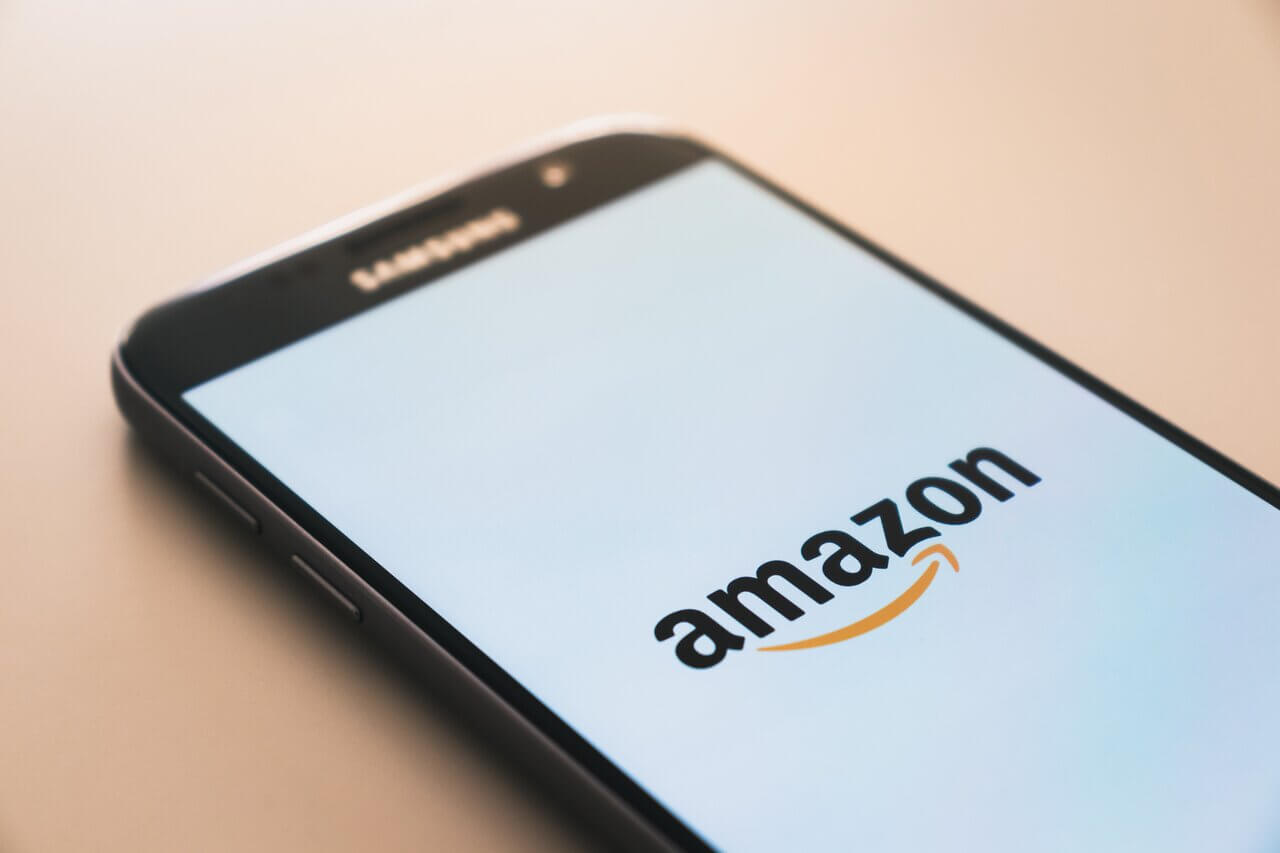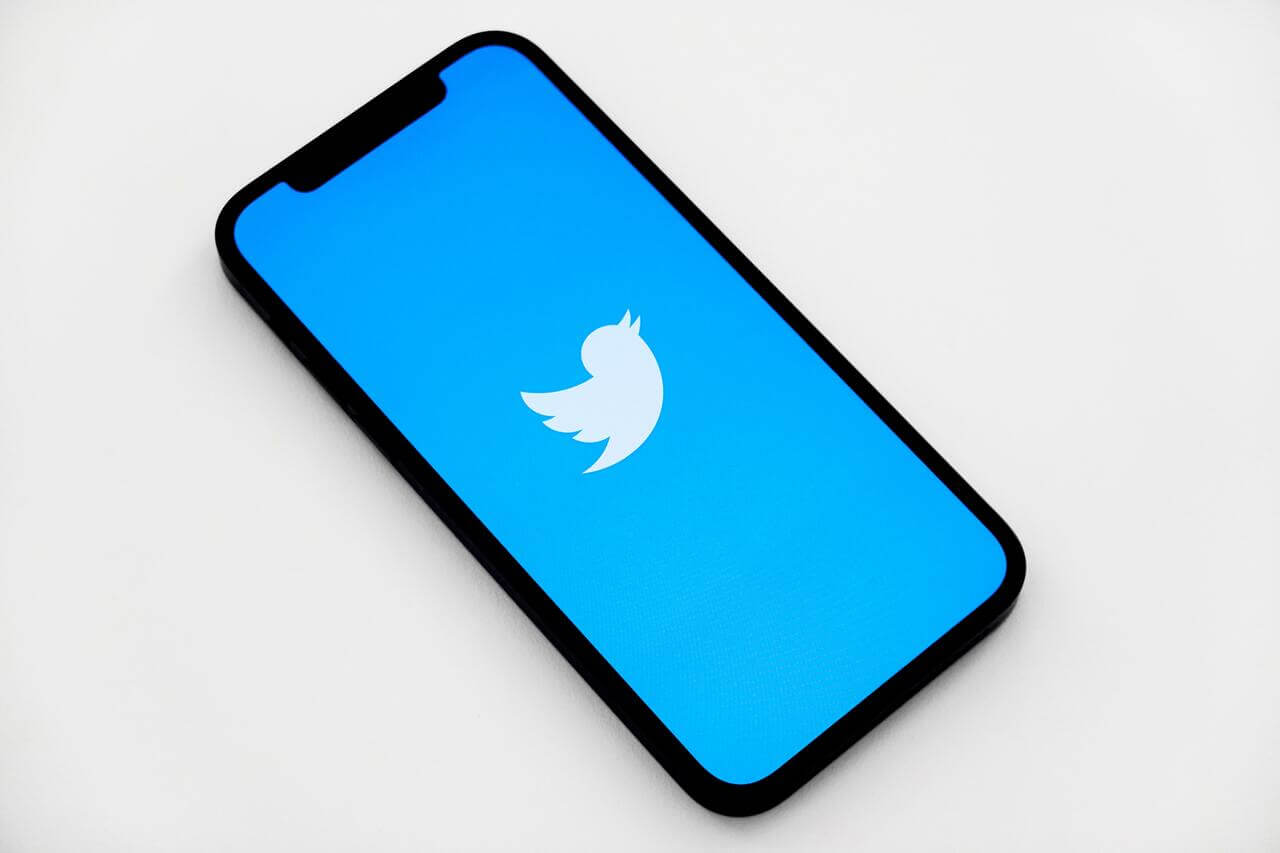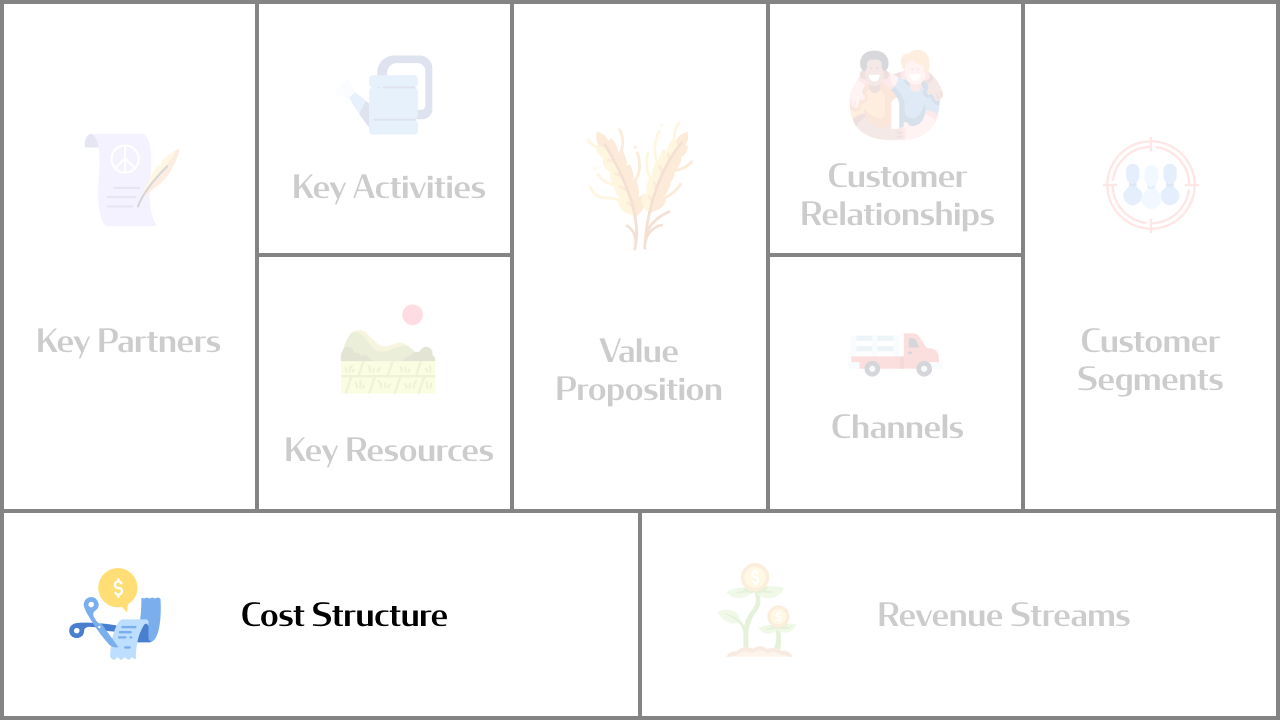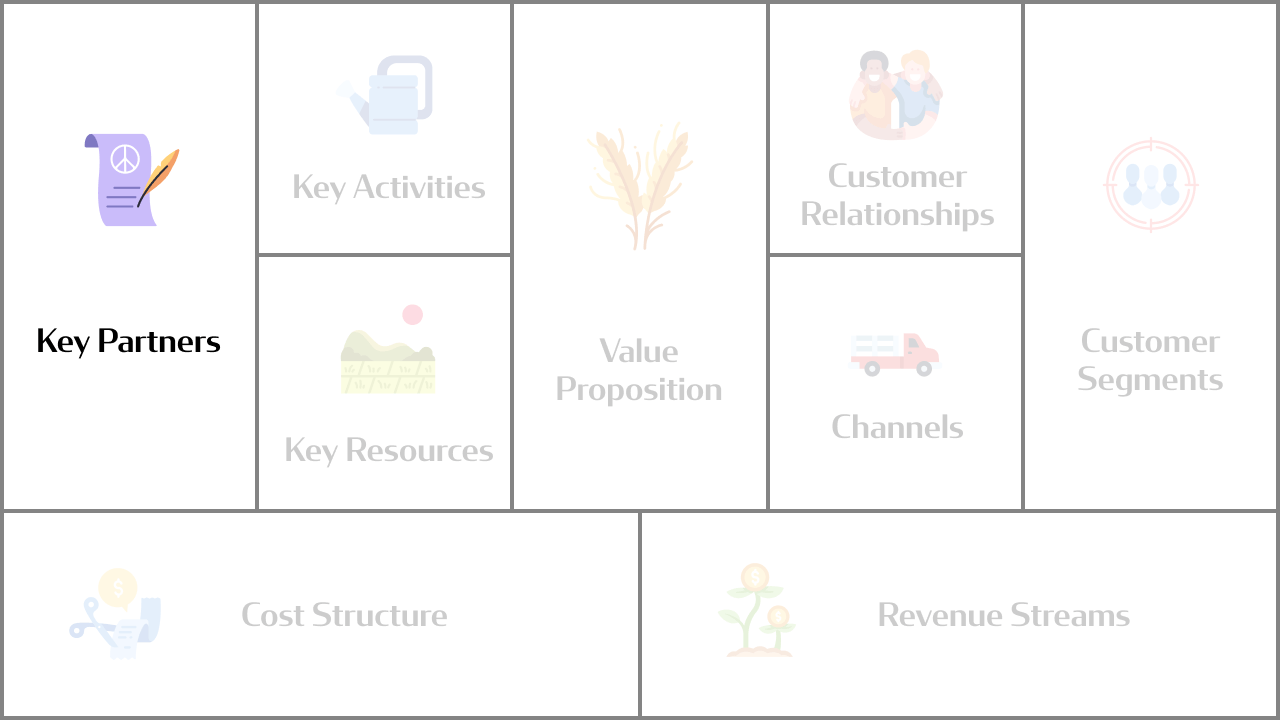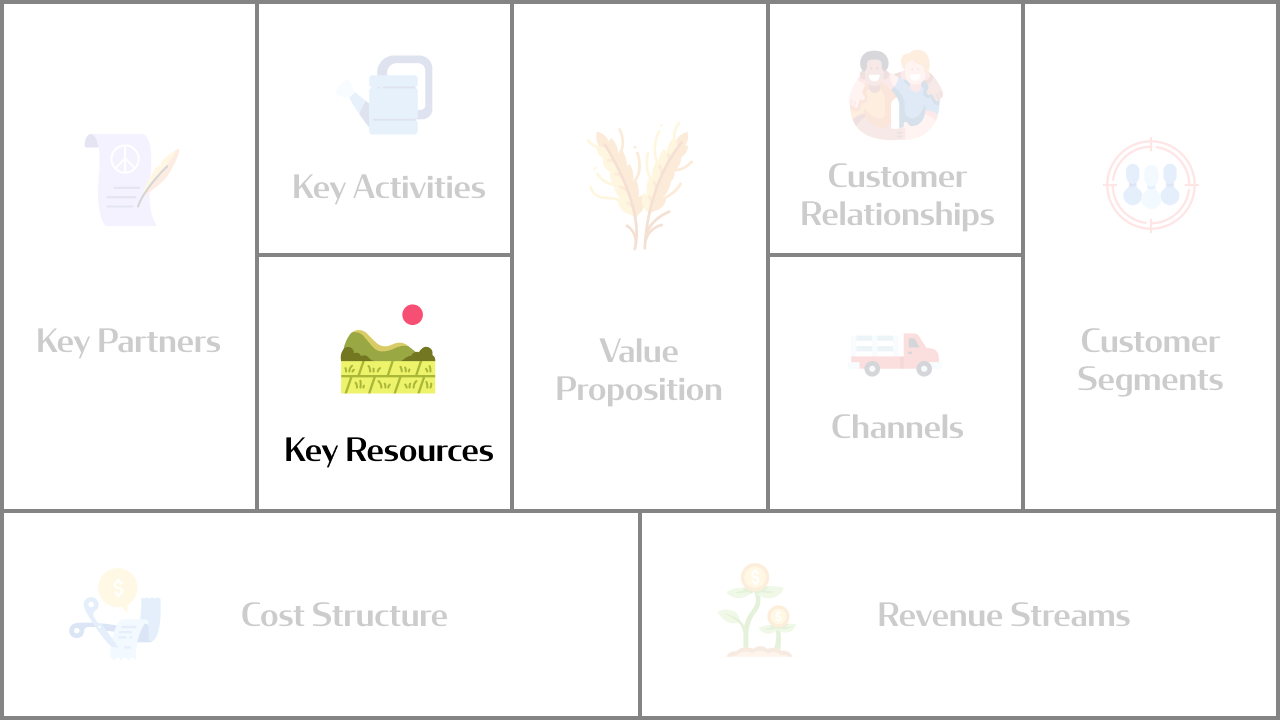Unless you’ve been living under a rock, you probably know just how big Apple, Inc. is. Over the last few decades, Apple has become one of the most recognized brands in the world. It’s been dominating the technology industry, becoming one of the most valued companies in the world.
As of August 2021, Apple had a market cap of around $2.43 trillion. With a business model based on innovation and consumer-centric devices, Apple can retain a loyal customer base through user-friendly designs, easy data migration to new product lines, and integration between Apple devices. Every time Apple drops a new iPhone, the long winding queues are proof of how successful its business model is.
But how did the company manage to create such a fierce love for the brand?
Apple created an entire technological ecosystem, often referred to as the Apple Ecosystem Lock. The company’s insistence on integrating its products makes it easier for customers to keep using new Apple products. Thus, it is more challenging to switch to a competitor’s product.
In terms of hardware and high-end gadget sales, Apple created brand loyalty in the early 2000s by radically aiming to put a computer in every pocket. Unlike the then-dominant Microsoft, whose focus was on putting a computer on every person’s desk. This nonconformist business model is what propelled Apple to the top of the technological food chain.
However, every success story also has a couple of failures along the way. Over the last 40 years, Apple has faced disappointing product releases, continued leadership, and legal issues. Nevertheless, its profitable business model has ensured Apple’s success.
Let’s take a look at how this giant was born.
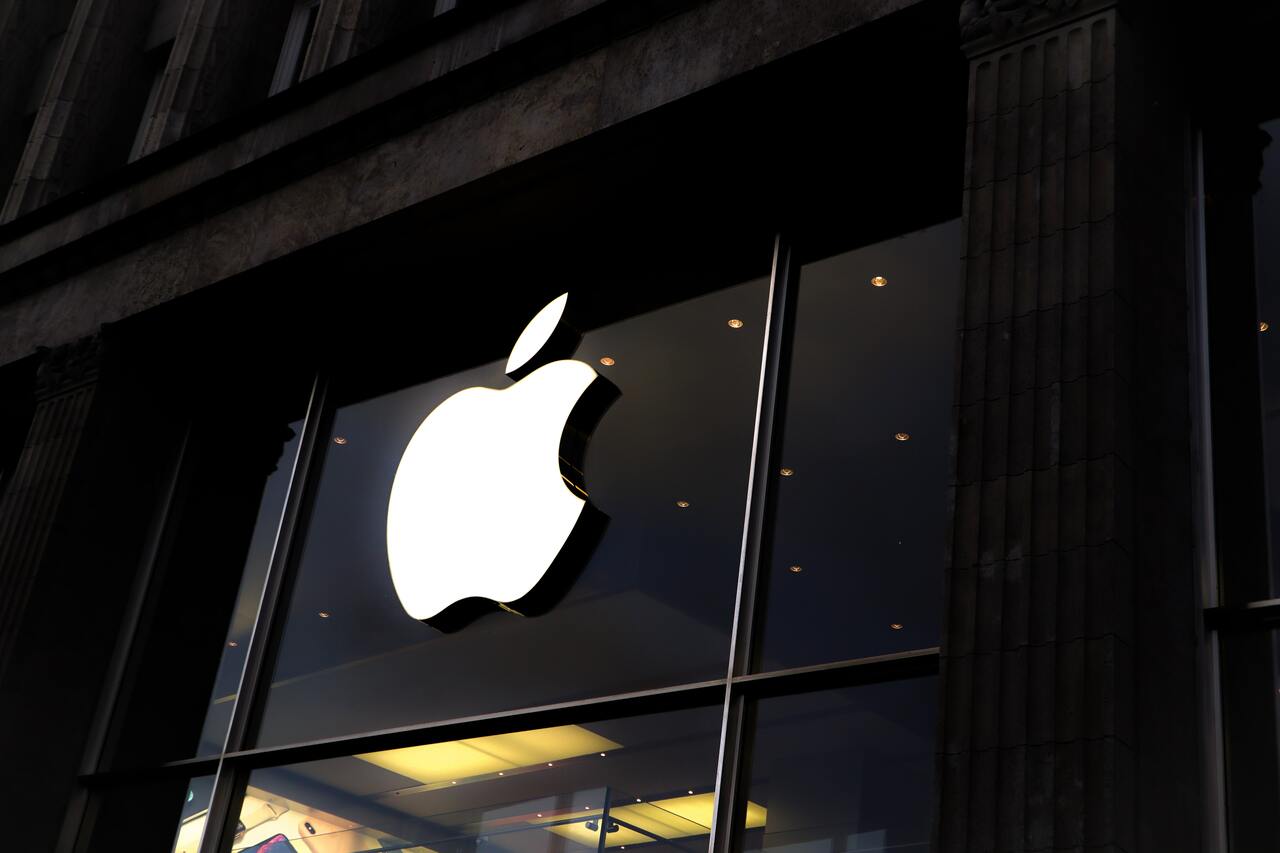
1971-1989: The birth of Apple
1971: The Beginning of Personal Computers
In the 70s, computers were big and expensive machines, and the industry was dominated by IBM. Additionally, only a handful of enthusiasts knew how to manage and use these technologies aside from the big corporations.
The idea for microcomputers began to take root among computer enthusiasts in Silicon Valley. Several people were building personal computers using parts such as the first chips manufactured by Intel.
During this time, the founders of Apple, Steve Jobs, and Steve Wozniak, first met through a mutual friend, Bill Fernandez, in 1971. They began their first business partnership later that year when Wozniak, who had experience in electronics, started to build his original invention called the “blue boxes.”
These boxes made it possible for people to make free long-distance phone calls. Jobs convinced Wozniak to sell some two hundred blue boxes for $150 each, and they split the profits. Wozniak was also working on several other inventions, one of them being a video terminal that he could use to log on to minicomputers.
1975: The first commercial, personal computer
In 1975, the Altair 8800 became the first computer to achieve commercial success. It, however, required the user to assemble the different components, so it had no real appeal to the average person. It mostly captured the hearts of electronic hobbyists and computer geeks who would have the know-how.
At the time, Wozniak could not afford to buy the microcomputer CPUs that were on the market. Instead, he decided to learn as much as he could, designing computers on paper. This paid off tremendously, and by 1975, Jobs and Wozniak had withdrawn from Reed College and UC Berkeley, respectively.
They started attending different meetings and conferences to gain more knowledge about the computer industry. One specific meeting they went to at the Homebrew Computer Club inspired Wozniak to build a microprocessor into his video terminal and have a complete computer.
1976: Apple Computer Inc. was born
In April, along with Ronald Wayne (who worked with Jobs at Atari), Jobs and Wozniak formed Apple Computer. Wayne designed the first company’s logo and prepared the first partnership agreement with a 10% stake. However, just twelve days later, he relinquished his stake to avoid any potential financial risk.
Wozniak finished working on his hand-built personal computer kit that was named the Apple I. It was a circuit board that lacked basic features like a keyboard, monitor, and case. Jobs had to sell his Volkswagen Type 2 minibus for a few hundred dollars. Wozniak sold his HP-65 programmable calculator for $500 to raise money to pay for the parts.
They used Job’s parent’s garage in Los Angeles, California, as their office and factory. The first public launch of the Apple I was at the Homebrew Computer Club. The computer received a warm reception convincing the pair to go commercial.
Wozniak offered the design to Hewlett-Packard (HP), where he worked at the time, but they turned him down. So he decided to sell the Apple I for a little more than the cost of the parts. All he wanted was to recover the money they had put into making the computer.
Partnership with Byte Shop
Jobs, on the other hand, had bigger plans. He approached a local computer store called The Byte Shop to sell them 50 units of the Apple I. It was a considerable risk for the shop for several reasons. First, there was not enough Apple I to fulfill the order, and Apple Computer Inc. didn’t have the money to produce them.
Atari, where Jobs worked, required cash for the components it sold him, and a bank he had approached for a loan had turned him down. While Job’s friend’s father had offered to loan him $5,000, it wasn’t going to be enough.
Fortunately, Paul Terrell, Byte Shop’s owner, decided to grant Apple the $500/unit purchase deal anyway. Jobs hoped that Wozniak could produce enough working computers to settle the bill from the proceeds (they were selling the Apple I for $666.66).
They roped in family and friends at a kitchen table to help solder parts they had bought from Cramer Electronics (a national electronic parts distributor). Once the computers had been tested, Jobs drove them over to Byte Shop. All in all, 200 Apple I units are sold.
1977-1978: Apple’s First Investor & the Apple II
On January 3, Apple Computer Inc. was incorporated. Wozniak designed the Apple II, an upgraded personal computer intended for mass-market production. Meanwhile, Jobs and Wozniak meet Mike Markkula, who invests $250,000 in the company.
Markkula was pivotal in securing credit and additional venture capital for Apple. He also recruits Michael Scott, who acted as Apple’s first CEO.
Wozniak and Jobs wanted to create a computer that would fit into the average person’s everyday life. Thus the Apple II was released in June of that year at a retail price of $1,298. The Apple II had a completely redesigned TV interface, with a simple text display and graphics.
Other competitors & Partnerships
However, it wasn’t the only personal computer of its kind on the market. Its rivals, the Commodore PET 2001 and the Tandy TRS-80 were launched at the same time. All three machines were designed to make personal computers as straightforward as possible.
Users didn’t need to have the computer skills required to start using one. However, the Apple II had something different; a color video connection and presentable packaging. The Apple II had no visible boards and wires. Additionally, Apple partnered with programmers Dan Bricklin and Bob Frankston, and the Apple II became the official carrier of the new VisiCalc spreadsheet program in 1978.
VisiCalc opened the way for Apple to enter the business market. Moreover, the fact that the Apple II was starting to have corporate clients attracted more software and hardware developers like Microsoft to the machine. In fact, Apple’s home user customer segment grew because of the Apple II’s compatibility with Microsoft Office’s basic program.
The value proposition of the Apple II was its flawless design and high performance. It’s no wonder that the product exploded in popularity. By the end of the year, Apple had made $750,000 in revenue.
1980: The Third Generation Computer & Going Public
After riding off the success of the Apple II for two years, Apple announced the arrival of the Apple III in May of 1980 during the National Computer Conference (NCC) in Anaheim, California.
Apple rented Disneyland for a day and commissioned bands to play in the Apple III’s honor. This third-generation PC was meant to solidify Apple’s hold in the business environment. Despite the success of the Apple II, IBM was still dominating the corporate computing market.
The Apple III was released in November at a retail price ranging from $4,340 to $7,800. While it was a relatively conservative design for computers of the era, it had some fantastic features that corporations enjoyed. For example, it had a typewriter-style upper and lower case keyboard and an 80 column display.
The following month in December, Apple went public. Selling 4.6 million shares at $22 per share.
Apple Business Model Canvas: The Early Days
At this point, Apple’s Business Model Canvas looked like this:
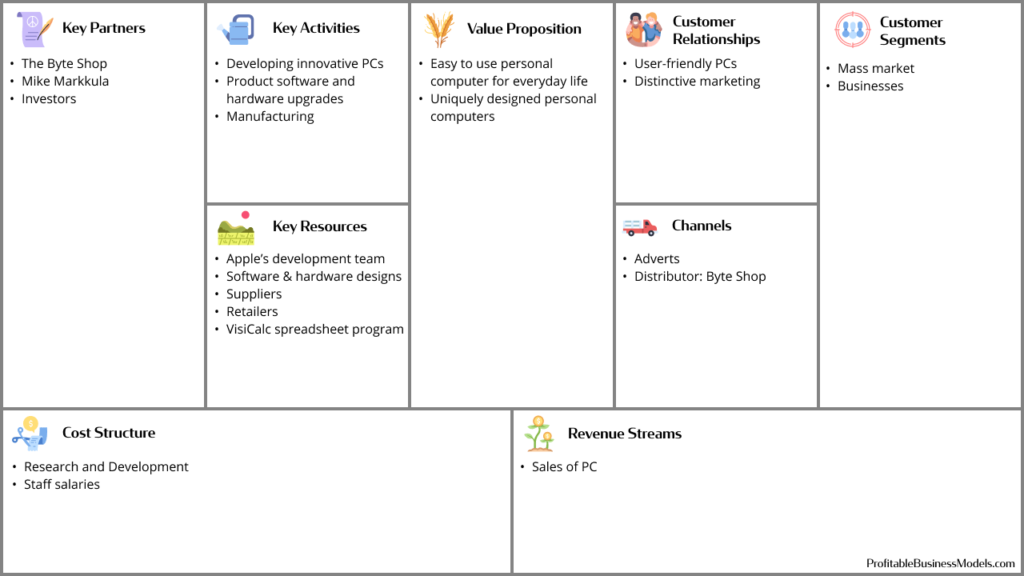
1981-1990: Product Failures & Fierce Competition
1981-1982: Competition from the IBM PC & Failure of the Apple III
By August, Apple was among the largest microcomputer companies in the industry. It was slowly overtaking giants like IBM and revenue in the first half of the year had already exceeded 1980’s $118 million.
In fact, the lack of production capacity was constraining growth. The pairing of the Apple II and VisiCalc ensured that businesses kept purchasing Apple’s PCs. When IBM discovered that all its corporate customers wanted VisiCalc, the computer giant quickly launched its own personal computer in August 1981.
However, Apple had many advantages over IBM PC. Firstly, Apple established a strong network of dealers in the US who provided them with parts for their hardware. Apple also had partnerships with hundreds of independent software developers and had an established international distribution network. Additionally, the Apple II had more than 250,000 customers.
The IBM PC had none of that. Fortunately for IBM, the failure of the Apple III would prove to be its saving grace. The Apple III had significant flaws and was prone to overheat, glitches, and minimal software. By 1982 Apple had to recall 14,000 Apple III computers, and Apple’s reputation for producing flawless computers tanked. It was a significant blow.
1983: The Apple Lisa
By 1983, Apple was losing ground to IBM. Revenue from the Apple II was dwindling, and Apple hadn’t released a successful product since 1977. Jobs had to act fast if Apple was to compete with the expanding personal computer market.
To gain a competitive advantage, Apple decided to move away from the text-based format that PCs were coming in. Jobs discovered a new technology by a company called Xerox that developed a demo PC with a graphic user interface and a mouse. He convinced Xerox to grant Apple’s Engineer access to the technology. In exchange, Xerox bought 100,000 Apple shares at a discounted price of $10 each.
The Apple Lisa was launched in January 1983. It was a high-end business machine that was targeted at business users. It retailed for $10,000, but unfortunately, it was a commercial failure. It had a lackluster software library and an unreliable floppy disk.
There were simply better and cheaper computers on the market, and the Apple Lisa failed to sell.
Problems with Apple Leadership Begins
Jobs had gotten so involved in the development of the Lisa that he had started bypassing the management structure of the company. This caused significant problems for him when the Apple Lisa failed to take off.
Michael Scott, the then CEO, and president and Mark Markkula created a new corporate structure that sidelined Jobs and stripped him of any responsibility for research and development within Apple. Looking for a new project, Jobs turned his sites to the Apple Macintosh, which had been in development for a couple of years.
1984: The Iconic Macintosh
Apple needed another hit to guarantee its future and target the lower end of the market as the Lisa. The Apple III had failed to make waves in the high-end market. This hit came in the form of the Macintosh. It combined the low production cost of the Apple II with the Apple Lisa’s features.
Before the launch of the Macintosh, Apple decided to increase its marketing budget. All the previous launches had been somewhat reserved. This time they wanted to create a buzz because they believed that much in their product.
Apple put a call to its ad agency and tasked them with securing sixty seconds during the third quarter break of Super Bowl XVIII. The production budget of this new campaign stood somewhere between $350,000 and $900,000. The commercial featured a sportswoman in red shorts in a sea of pale men, all dressed in grey clothing sitting down on benches in front of a big screen.
The woman is holding a sledgehammer and is being chased by police-like figures as she runs towards the screen. The commercial ends with the woman throwing the hammer at the screen and a voice-over announcing:
On January 24th, Apple Computer will introduce Macintosh.
And you’ll see why 1984 won’t be like “1984”.
It was an indirect reference to how IBM was dominating the PC industry and how Apple was trying to break the monopoly. The “1984” phrase was taken from a novel by George Orwell where the earth is controlled by “Big Brother”.
The ad was a hit and the Mac went on sale in January 1984 at a retail price of $2,495. While it wasn’t cheap, it was good value for money, and sales skyrocketed.
The Mac fails to make significant traction.
Although the Macintosh was received well, it still needed a killer application, as VisiCalc had been on the Apple II.
The PageMaker was a desktop publishing computer program that helped users create ads, brochures, newsletters, and books was Mac’s golden ticket. It was backed up by the revolutionary Apple LaserWriter printer. It would establish the Mac as a contender in the low-end market. The LaserWriter was the first mass-market laser printer, even though it wasn’t the first laser printer.
Unfortunately, the Mac was three times more expensive than the average PC. Moreover, the new graphic user interface required much more effort for existing software developers to make new programs compatible with the Mac. This resulted in very limited programs and applications for the Mac.
Apple was also against IBM in the home customer segment. IBM had a stronghold in the corporate world. Many customers who used IBM computers at work simply decided to go with what they knew when they bought their first home computers.
The IBM PC came with a range of software and included the hugely popular VisiCalc spreadsheet program and the EasyWriter word processor. Within a few months, sales began to dwindle as consumers were not interested in an expensive PC that was not compatible with anything. This led to conflict within Apple’s leadership.
1985: Jobs is forced out of Apple
Although Steve Jobs was Apple’s most public face and the company’s co-founder, he wasn’t its CEO. Apple’s leadership has changed hands a few times since 1976. In the mid-80s, John Sculley was hired by Apple to run the company.
At first, Sculley and Jobs got along; however, Jobs had the vision to create a computer for the mass market. He wanted a computer that would cost $1000 or less; unfortunately, production costs had doubled the price.
Jobs and the development team had pegged the Mac at $1,995. Still, Sculley, who needed to ensure profitability, insisted on hiking the price by an additional $500. This caused a lot of friction between the two men.
The tanking sales of the Mac increased the tension, and the board urged Sculley to reign in Jobs. They felt that he was taking unnecessary risks, putting the company at risk financially. Again Jobs was stripped of his duties with the Macintosh team and given a ceremonial role as Chairman. Jobs was not happy about this demotion at all and decided to launch a coup.
Unfortunately, Sculley got wind of it, and Jobs was forced to resign. He took with him a few Apple employees and went on to start a company called Next.
1986-1997: The decline of Apple
1986-1992: An Identity Crisis
The departure of Steve Jobs signaled the beginning of an immense identity crisis for Apple. Up until now, Jobs had driven the company’s direction towards one single goal; making low and high-end PCs at a consumer-friendly price.
Sculley and the board wanted to go in a different direction. They wanted Apple to be a premium computer company that sold cutting-edge products. Since Apple already appealed to creative business users, they figured that the most logical step was to target the high-end market. They settled for more powerful and thus more expensive Macs.
Apple raised the price of the Mac at a time when competing PCs from Microsoft and IBM were becoming cheaper. The strategy was to create demand by selling fewer units at a higher price, resulting in higher profits. Boy, were they wrong! Despite the unique user interface that created brand loyalty, Apple’s stock prices and market share continued to decline.
They introduced several products such as the Centris PC line, a low-end Quadra offering, and the ill-fated Performa PC line. These products were sold with many configurations and software bundles to avoid competing with consumer outlets such as Sears, Price Club, and Wal-Mart. They were the primary dealers for these models.
1993-1997: The Dark Years
In 1993 Michael Spindler replaced Sculley as CEO. Spindler completely restructured Apple, laying off 15% of the workforce and splitting up the product development team according to the market. He wanted to focus on building as many cheap products as possible.
Not only did this weaken the product development team, but it also caused a lot of confusion. The product line was so complicated that no one could identify which product was best for which market.
Apple experimented with several failed consumer targeted products that included digital cameras, portable CD audio players, speakers, video consoles, and TV appliances. Unfortunately, none of these products helped, the company continued to experience challenges. None of its products were seeing the success that the Apple II had enjoyed. There were simply better alternatives on the market.
1994: Microsoft: The New Giant in Town
At this time, Microsoft began making significant strides in the market. Its Windows software was proving to be highly reliable, and it came at an affordable price. Microsoft continued to gain market share.
To address Microsoft’s growing dominance, Apple joined forces with IBM and Motorola in the AIM alliance. The aim was to create a new computing platform that would use IBM and Motorola’s hardware and Apple’s software. The AIM alliance hoped that the new platform would replace the PC and thus counter Microsoft.
The same year, Apple launched the Power Macintosh, the first of Apple’s computers to use Motorola’s PowerPC processor. The following year Apple decided to license the Mac Operating System and Macintosh ROMs to 3rd party manufacturers to produce Macintosh “clones.” They wanted to achieve deeper market penetration and earn extra revenue for the company. However, this backfired as the clones were competing with Apple’s Macs and reduced Apple’s own sales.
1996-1997: Steve Jobs Saves the Day
In 1996, Spindler was replaced by Gill Amelio. Amelio implemented more layoffs and cost-cutting measures to try and keep the company afloat. It was clear that Apple was dying a slow and painful death. They just could not keep up with how quickly the tech industry was changing.
While Apple had experienced initial success with the Apple II, once competitors developed similar and more stable technologies, Apple could do little to stop the inevitable. It had lost the element of surprise.
Realizing this, Amelio tried to improve Mac OS, but nothing was working. In a last-ditch effort, he chose to approach Steve Job’s NeXT and its operating system. He also decided to bring Steve Jobs back to Apple as an advisor.
In July 1997, Gil Amelio was fired, and Jobs became the interim CEO. He began restructuring the company’s product line, creating a dream team to drive up innovation. They decided to launch just four computers, the iMac, Power Mac, iBook, and the PowerBook.
Furthermore, he partnered with Microsoft agreeing to release new versions of Microsoft Office for the Macintosh. In exchange, Microsoft made a $150 million investment in non-voting Apple stock.
In November, Apple introduced the Apple Online Store launching a new build-to-order manufacturing strategy. They closed off the year, having sold 80,000 units of their four products, creating a constant income stream for the cash-strapped company.
Apple Business Model Canvas: The Dark Days
At this point, Apple’s Business Model Canvas looked like this:
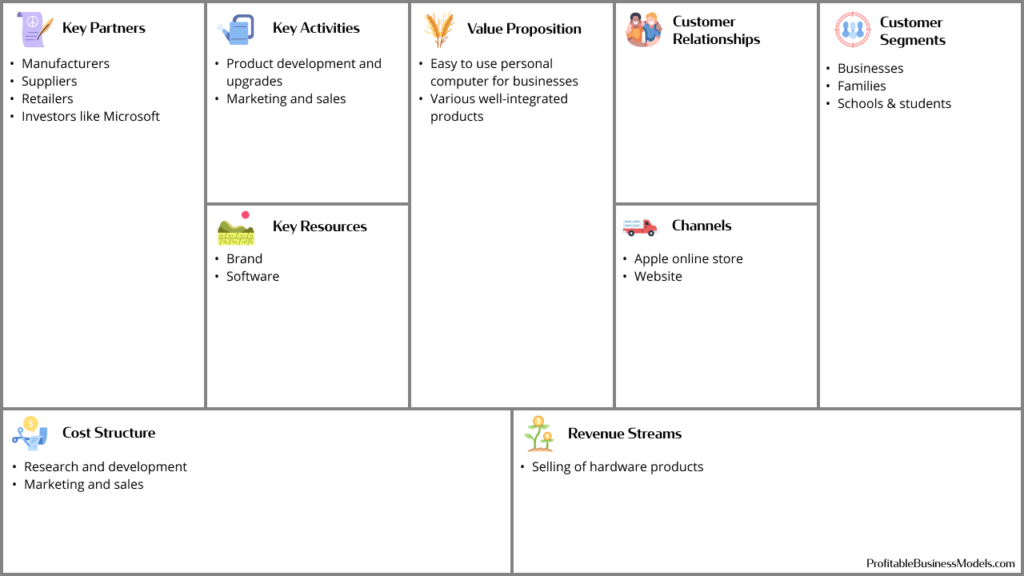
1998-Present: Return to Profitability
1998-2007: Moving Beyond the PC & Key Acquisitions
In August 1998, Apple introduced a new all-in-one computer similar to the Macintosh 128K: the iMac. The iMac had modern technology and a unique design. Within 5 months, it had sold almost 800,000 units.
Apple made several vital acquisitions throughout this period:
- In 1998, Apple bought Macromedia’s Final Cut software. This was a move into the digital video editing market.
- In 2001 they bought Spruce Technologies, a DVD authoring company that had developed a software called DVDMaestro. This software was a direct competitor to Apple’s own newly released DVD Studio Pro 1.0. Apple wanted to incorporate the features of DVDMaestro into its new DVD Studio Pro 2.0 software.
- In 2002, Apple purchased Nothing Real’s Shake app. It was a high-end video compositing software application that enabled Apple to integrate it into their computers for better video quality.
2001-2003: First Official Store, iPod, and iTunes
In 2001 after years of development, Apple released the Mac OS X aimed at the average consumer and the professionals. In May that same year, Apple opened the first official Apple Retail Stores in Virginia and California.
A few months later, in October, Apple announced the iPod portable digital audio player and started selling it on November 10. The iPod was a phenomenal success. In 2003, Apple’s iTunes Store was launched, offering online music downloads for $0.99 a song. Users could integrate iTunes and the iPod.
Soon Apple became the market leader in online music services.
2007-2011: The iPhone, App Store, iPad & iCloud
In June, Apple introduced what was to be their best-selling product yet, the iPhone. During the Macworld Expo, Jobs announced that Apple Computer Inc. would now be called Apple Inc. The reason was that the company was now focusing on mobile electronic devices and not just PCs.
This led to the development of the iPhone, iPod Touch, and the iPad. Apple became the first to achieve a mass-market adoption of the touch screen user interface with pre-programmed gestures. Additionally, Apple expanded its business model and introduced its App Store to purchase third-party software applications.
The iCloud was launched in 2011. The online storage and syncing service for music, photos, files, and software solidified Apple’s Ecosystem. Users of Apple products could seamlessly move from one device to another and still have access to their data. This signaled the beginning of the Apple we know today.
Unfortunately that same year, Steve Jobs passed away and with his passing Apple began to lose some of its competitive edge and innovation.
Apple Business Model Canvas: The Profitable Days
At this point, Apple’s Business Model Canvas looked like this:
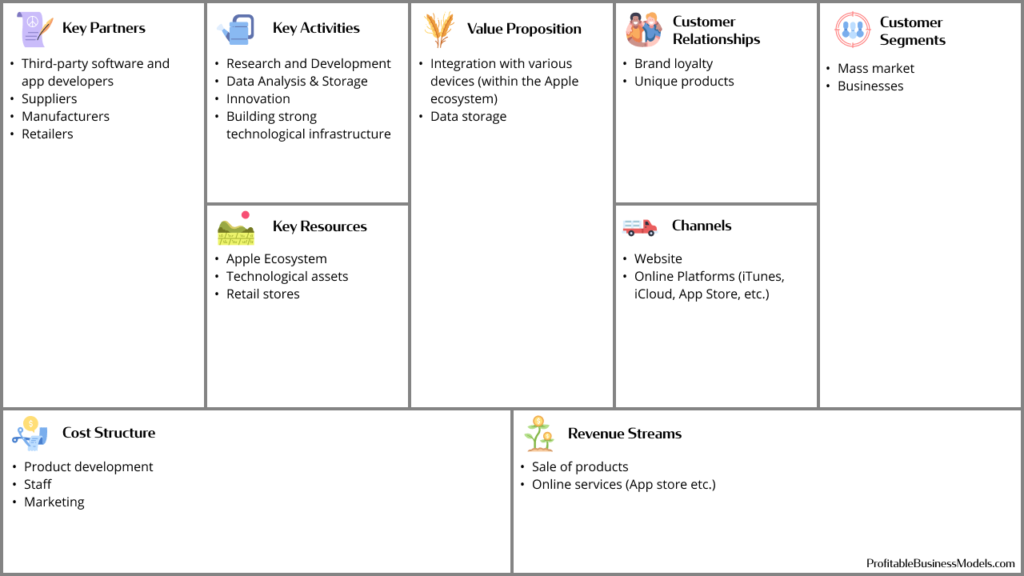
Conclusion
The Apple we see today is a far cry from the highly rebellious, non-conformists start-up it was under the guidance of Jobs. Jobs’ greatest skill was relentless internal competition. While Tim Cook (who now leads Apple) has focused on making the company profitable, it’s clear that he follows a more conservative approach.
The danger for Apple now is that 90% of its business is now centered on one product; the iPhone. Apple has fallen into the classic monopoly trap where because of its dominance they’ve stopped innovating and are now focusing instead on protecting their core business.
History is clear, monopoly is never a good place to get comfortable. Just look at Microsoft, it was late to the internet, late to the cloud, and late to portable music players, all because it was trying to protect its Windows software.
Time will tell whether Apple will survive a post-mobile phone era with this strategy.
Sources:
- https://finance.yahoo.com/quote/AAPL/
- https://www.marketing91.com/business-model-of-apple/
- https://www.bailiwickexpress.com/jsy/life/technology/apple-timeline-key-milestones-companys-40-year-history/
- https://www.nydailynews.com/news/national/apple-turns-40-timeline-tech-giant-evolution-article-1.2581048
- https://www.macworld.co.uk/feature/history-of-apple-steve-jobs-mac-3606104/
- https://www.investopedia.com/articles/personal-finance/042815/story-behind-apples-success.asp
- https://www.nytimes.com/2015/01/30/business/how-and-why-apple-overtook-microsoft.html
- https://www.investopedia.com/articles/markets/111015/apple-vs-microsoft-vs-google-how-their-business-models-compare.asp
- https://medium.com/age-of-awareness/what-made-apples-1984-advert-so-successful-dc5af1b073f3



